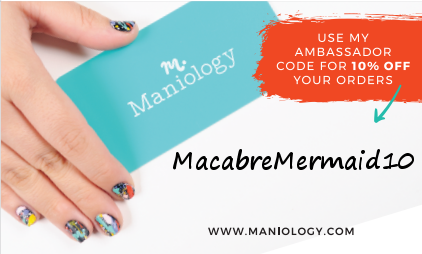A lot of people enjoy going to the salon for a manicure because it makes you feel pampered. Your hands also feel like they have been taken good care of because someone who knows what they're supposed to do has done all of those things for you. So, now that you are doing your mani at home, what to do?
I've never really been one for going to the salon for a mani or pedi, although I have had it done before. The nice thing about doing this at home for yourself is you're saving a lot of money.
Here in the US they usually will soak your hands and/or feet to soften up the cuticles. Then you can scrape, push, cut and remove that old, dead cuticle skin. (In a video on the Maniology website, I learned that is actually illegal in Hawaii to cut your cuticles!)
I've also learned that you can permanently damage your nails' growth ability if you are too hard on (what we might mistakenly call) the cuticle. We need to take care of the living part of the skin, which is called the eponychium, and only push back the old dead cuticle skin. The eponychium is the living part of skin attached to your nail bed. It protects against infections. Take care of it, so it can take care of you. Also don't clean too aggressively underneath, for the same reason. You could damage your hyponychium.
Thanks to the internet I also recently learned that in some places they will grind it away instead of sanding it away. Look up the Russian manicure if you're curious. It's also called a dry manicure. (But there are downsides to it, too; see link below.)
Soaking your nails in water before a manicure will actually make them soft and more pliable which is not good for the paint. My way around this has always been to just work on my cuticles after I have taken a shower while they are still nice and pliable. I do this on a day when my nails are at rest, meaning no polish that day. I think it is good to let them breathe once in awhile - "naked."
So the day before I'm going to do my nails, I usually take my old polish off and give them a day or two to rest in between (sometimes longer, if I don't have time!).
Then, I use the cuticle pusher to push back the dead skin. I might use the scraping tool to clean it off the nail better sometimes, while taking care not to scrape into the nail itself. You don't want to thin out your nail in this manner. I do this often enough so that I don't need to worry about cutting excessive amounts of dead skin away. But if you need to do any cutting, basically remember that's all you should be removing - the dead skin. In other words, don't make anything bleed!
You'll want to clean your nails before putting products on to prevent trapping bacteria and germs underneath, which could cause an infection. In the above "cuticle" steps, you also are taking care not to cut yourself because this too can result in infections. If you should nick yourself and make it bleed, keep it clean and use peroxide to hopefully prevent any infections, though.
I also put some Hard as Hoof on my nails to help strengthen and treat them while they are bare. Some people put cuticle oil on their cuticles to help moisturize and keep the skin and nail healthy.
Product link on Amazon: https://amzn.to/3Roqri8
Cut and file your nails as needed. Lightly buff them to even out the surface if needed - do NOT overdo it though, so as to not thin out your nails! (I have very grooved nails so sometimes I bring the ridges down a bit in this manner.) Wash your hands/nails, and use a nail brush to clean under the nails. Dry your hands.
Some people need to remove additional oils from their nail before applying polish, if their skin is especially oily and polish doesn't adhere or stay on well. This can be as simple as applying rubbing alcohol. Some people also apply a primer to help gel polish adhere better to nails, and to protect the nail from staining. I don't use gel, and I also don't oil my cuticles, so I skip this part. I think it would be wise to rinse away any product you use, even if alcohol just to prevent any residual film from staying behind. Air or towel dry with a clean cloth.
Now you're ready to move on to the next step and paint those nails!
Don't moisturize the hands until after the polish has dried, but DO moisturize both your hands and your cuticles afterwards. Applying oils beforehand would negate all the careful cleaning and removing of oils beforehand. :)
Helpful link: https://www.youtube.com/watch?v=n2fWQe6YoFA
Read more about the Dry manicure process, if you're curious: https://www.rd.com/article/russian-manicure/
By the way, always be sure to use a proper respirator to protect your respiratory system if you file off polish, resins, gels, etc., because lung cancer is no joke.
As a personal opinion, though: I don't recommend the dry process.
Also, here is more info about your cuticles and your Hyponychium, which I found to be VERY interesting, and should help you understand them better too:
Best layman's terms: https://nordicbeauty.be/2016/10/05/eponychium-vs-cuticle/
More knowledge: https://nailknowledge.org/nail-knowledge-base/the-eponychium
Best diagram: https://schoonscientific.com/2017/the-eponychiums-dilemma/






0 Comments